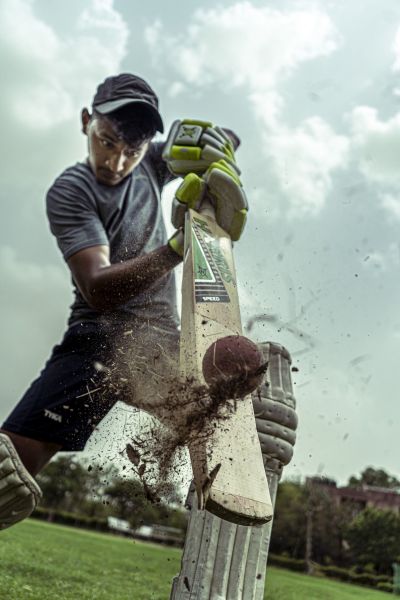Hit the sweet spot
- POSTED ON: 14 Aug, 2023
- TOTAL VIEWS: 363 Views
- POSTED BY: Peeyush Sekhsaria | Article by R. Krithika
- ARTICLE POINTS: 150 Points

The cricket bat has come a long way. Comprising a handle and a blade, it is perhaps the mostly widely found object in Indian homes. With a total length of 38 inches maximum and width of 4.25 inches, the blade is generally flat on the front. A ridge on the back concentrates wood in the middle where the ball is generally hit. The handle is made of laminated cane and rubber and a tapered splice secures it into the blade, improving load transfer and reducing the chances of breaking. Typically, bats are made from a specific British willow (Salix alba var. caerulea).
Bats were not always this shape. While the first mention dates back to 1624, the earliest forms of cricket were most likely played by shepherds with a lot of time to kill, and their bat, not surprisingly, was their hooked stick. The oldest existing bat, dating back to 1729, is shaped more like a hockey stick. The bowling, till the mid-19th century, was underarm. So, the lowest portion of the bat needed to be solid, like a hockey stick. Once overarm bowling established itself, the location for the thickest portion moved upward and the design has been more or less the same for close to 50 years.
Interestingly, the British gave us the bat even before they gave us first-class cricket. They introduced the willow in Kashmir in the early 19th century — not for bats but for firewood after considering the weather. The species thrived and, about 100 years back, an industry took off that today employs over 10,000 people and also produces over a million bats.

Despite being made from the exact same species and being used by players like Viv Richards and Sachin Tendulkar, Kashmiri bats were considered inferior. But, after their debut in the T20 World Cup 2021 and the official status in the ICC Men’s Cricket World Cup 2023, they have made it to the international stage.
But will future bats be made from willow? The species is dwindling both in its original home and in the Kashmir valley. An alternative that has been tested with good results is made by sticking layers of bamboo together. This is lighter and thinner and also has a better performing sweet spot. Not to mention, it is also a lot cheaper. There is also a possibility that this may make cricket popular in Southeast Asia and China, where bamboo grows in profusion. Bamboo bats are not yet accepted, as the law states that cricket bat should be made of wood. And may be the bamboo reminds them of the shepherd’s crook.
Now that you’ve read all about how the cricket bat originated, try your hand at this crossword. Remember, the names are all last names.